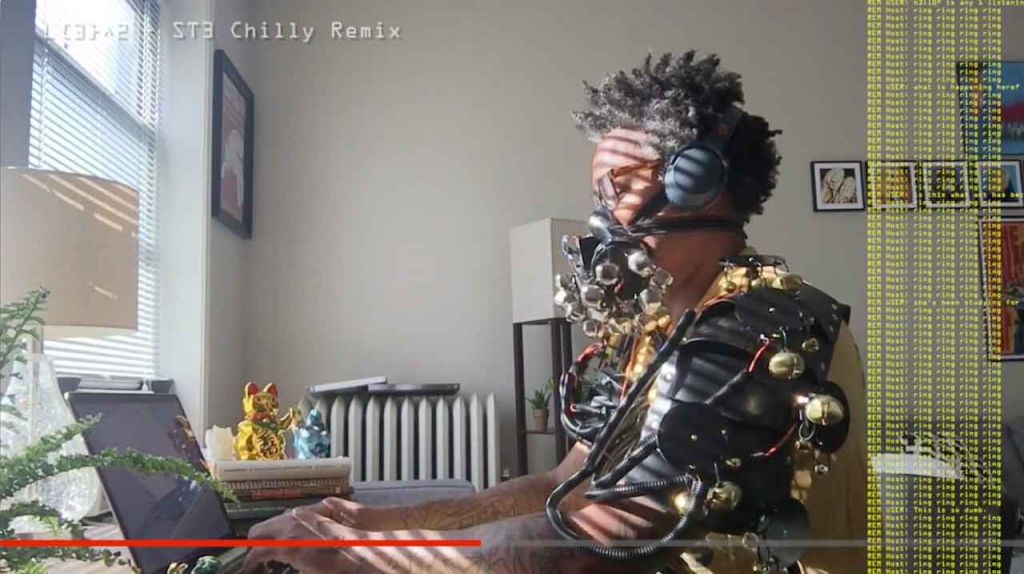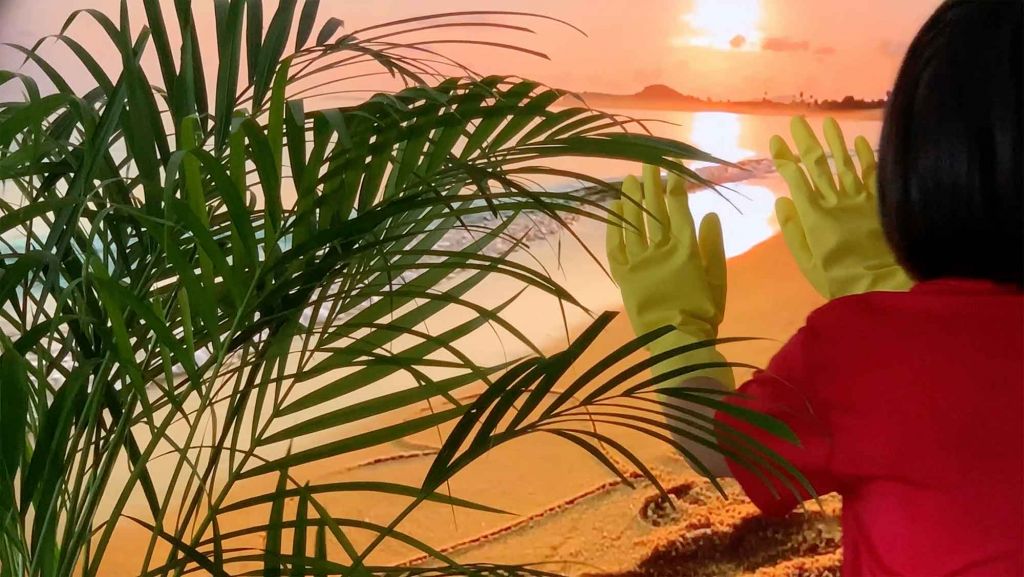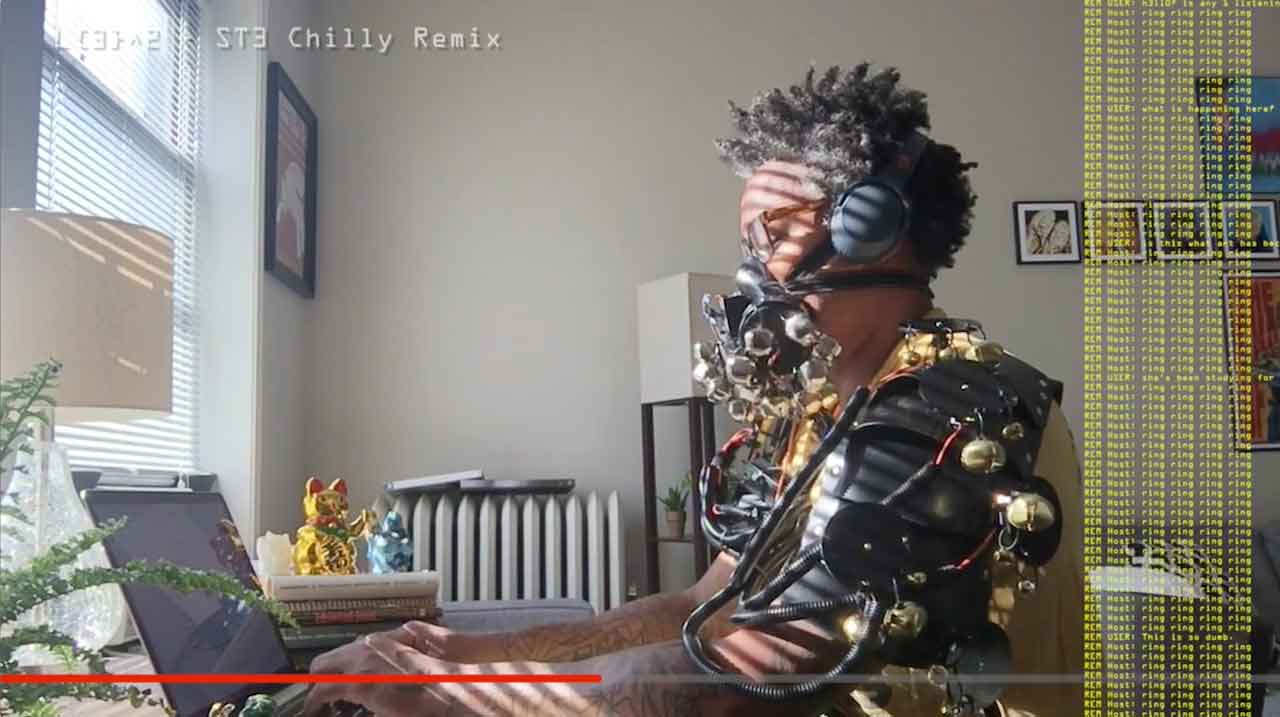Text by Silvia Iacovcich

Cyborgs squatting in a bathtub with clanging bells dangling from their gas masks, VR turtles flying over your head, and a profile of our deepest secrets exposed from data mining are welcoming you at the new digital exhibition at NYUAD. Technology has filled our spare time with content-saturated, screen-regulated reality as we get accustomed to the streaks of pandemic lockdowns.
At the same time, we continue our existence within the four walls of our homes. Art institutions, blindsided, have responded to the trend with lavishing 3D rendering; in the meantime, VR still races to live its golden age. In between cat videos, cooking adverts, and DIY whatsoever, ‘Not If, Or Along, Or Relating To A Line’ infiltrates our phones, investigating the metamorphosis of our digitised identities and the pandemic role in our high-tech existence.
The title is the definition of the word ‘non-linear. Maya Allison, Founding Director of the Gallery and Chief Curator at New York University Abu Dhabi, explains in our email exchange how the exhibition, co-curated with NYUAD faculty member and artist Heather Dewey-Hagborg, is inspired by the old days of the consumer internet.
Heather spoke of how early internet theorists hoped it would give rise to a different way of thinking, a non-hierarchical way that allows you to move through ideas nonlinearly. If we change how ideas develop – from the linear of writing to the nonlinear of hyperlinked interconnections – perhaps a new kind of originality can emerge.
Allison’s background is in academic museums, including at the RISD Museum (Rhode Island School of Design) and as a Curator at the Bell Gallery (Brown University); she has curated numerous exhibitions, and her aim is to explore new paths that force the art world into a new digital sphere is palpable. When the pandemic meant it was time to “pivot”, I knew that the time had come for what I’ve often imagined: an exhibition that didn’t live in the physical gallery but that was not merely a list of links for clicking.
The exhibition challenges our auto-definition as singularities. We are given a QR code as the gate to a web platform, made exclusively for our phone, where a series of forking paths push us to always choose between two artists. In Lee Blalock’s Ev3ryd4y CybOrg TV’, a voice assures – There is nothing wrong with your screen – before a cyborg and his trivial habits make us feel awkward. Micha Cardenas’s Redshift and Portalmetal reinforce the dilemma: Do you want to save the world or not? – offering you to help here or live on the Ice Planet in a reimagined dystopian future. The path is simple. Just follow the blue line.
A key point here is that we humans co-create our identities through technology, Maya Allison explains while describing the artworks. The artist duo Eva and Franco Mattes make a portrait of themselves as generated by the “big data” of their emails and online activity. Zach Blas makes sculptures that his performers wear on their faces, painful reminders of how facial recognition software defines their features without their consent. Cao Fei makes a virtual reality double of her son, someone for him to play with during the pandemic.
Lee Blalock creates mechanical-sculpture extensions that she wears in her cyborg character performances, in which she looks like nothing so much as us right now, glued to our smartphones, with our headphones, and our computers, all going at once, beeping and lighting up as we gaze into the distance.

The ten artists try to reconcile with a more realistic experience of our communal present through the only place where we can easily absorb information today – our phones. And this is a great experiment! Maya Allison continues, We are all bemoaning the virtual galleries while acknowledging their necessity. What can we do, though, that has the immediacy that virtual tours cannot?
And considering the average amount we spend on the phone has now reached historic highs, there’s no better way to find out. Maya Allison adds: Our mobile phone is where we go for that endorphin hit of contact with humanity, in all its horror, mundane comforts, and transcendence. What do we do? We scroll through images and clips, in a non-linear fashion, discovering as we go.
This curatorial approach is inspired by the rhizomatic structure of the World Wide Web of Deleuze and Guattari, where the internet is imagined as a plant sending out roots and shooting as it spreads. It resists chronology with no point of origin, central locus, or specific organisation and favours a nomadic propagation system.
The sharp knife of restrictions and freedoms that a digital landscape offers – mostly during the pandemic – gives us, on one side, the option to reimagine our existence, on the other, to find ourselves in a state of perpetual isolation.
An inbred substratum that lays in the exhibition, as Maya Allison explains: As I reflect on it, it seems a logical outcome of those early internet theories. With all this uniqueness, we risk losing shared connections. This is a tension inherent in the project, but we conceived of it more from a curatorial perspective; often, curating a gallery exhibition, I work to develop a “through-line” for the visitor, a path they take through the narrative of the exhibition.
Replicating the complex social processes of reality – the mediacy, the representation and awareness that art is not reality, can reproduce some affinity with the physical gallery while enhancing our identity journey. Maya Allison continues: We give the experience of making choices as you travel through the exhibition, but we have carefully laid out the path so that the overall contours of the journey will be shared if you start from the beginning. Ultimately, museums offer forking paths as well, but we are less conscious of the choice in the way that clicking an option forces us to be conscious of our choice of routes.
The project comes after a series of online events run by NYUAD Art Gallery in 2020. Since its opening in 2014, the gallery always held to a hybrid vision. But the freedom of not having the requirement of a commercial gallery or a major museum has allowed Maya Allison to push through gaps in curatorial models, filling the gaps in art histories, testing the limit of curatorial practice in different ways – as this last show successfully shows.
What has changed? Maya asks, talking about the differences pre and post-Covid. Before the pandemic, we went from being the only year-round venue on Saadiyat Island to being neighbours with the Louvre Abu Dhabi. Fantastic. International audiences merged with local ones, and it’s a heady conversation until the pandemic stopped travel. We see two opportunities simultaneously.
On the physical front, the first is to commit to the hyper-local audience; on the virtual front, the second is that we’ve never been more able to cross borders and time zones so fluidly. Virtual events abounded in the last year, and much of it was forgettable. But when they are good, they can feel genuine and transcendent, connecting humanity much in the way we see with art. More of this, please.
Yes, more of this. Please.






